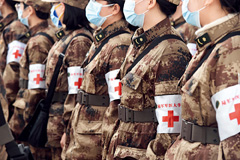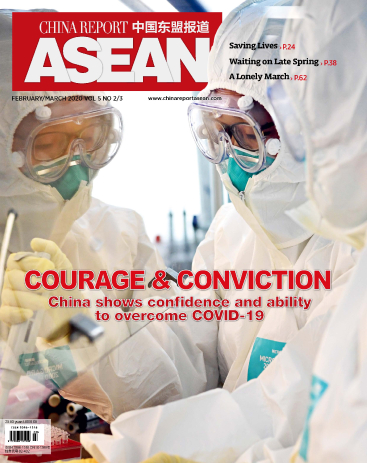An old Chinese saying suggests that when trouble occurs in one place, help should come from all directions. Since the very start of the COVID-19 outbreak, military medical teams and health workers from across China have converged on Wuhan, the epicenter, working around the clock. Wuhan is in the minds of everyone in China.
Alongside Wuhan, small and medium-sized cities and the vast rural areas of Hubei Province are also struggling. Compared to Wuhan, the capital of Hubei Province, these places do not have as many medical resources and assistance, which limits their efficiency in testing and treating COVID-19 cases. Some county governments even posted SOS notifications on their official websites to ask for help.
At a February 7 press conference of the joint prevention and control mechanism of the State Council, officials of the National Health Commission (NHC) announced organization of a pairing assistance mechanism to help Hubei provide better treatment for infected patients and secure safety and health of local people.
Targeted Assistance
At a special meeting of the Standing Committee of the Political Bureau of the Communist Party of China (CPC) Central Committee convened to discuss the outbreak, President Xi Jinping stressed that work on containment and mitigation of the epidemic should vary based on different conditions. To solve the shortages of medical resources facing many cities in Hubei, the most effective strategy seemed to be “pairing assistance” in which different regions could offer targeted assistance. According to the NHC, the pairing assistance scheme is not “one-to-one” exactly. China's 19 provincial-level regions have been paired up with 15 cities and the Shennongjia Forest District, other than Wuhan, in Hubei.
Earlier, many top medical teams from Beijing-based Peking Union Medical College Hospital, the First Affiliated Hospital Sun Yat-sen University in Guangdong Province and hospitals affiliated to Fudan University in Shanghai had already arrived in Wuhan to work together with local peers to fight the epidemic.
The composition of medical teams was primarily determined by shortages of medical resources in epidemic-hit areas and specific types of personnel needed in different places. Medical providers are professionals from departments of respiratory diseases, infectious diseases and Intensive Care Units. Priority dispatches of personnel from these specific departments can effectively meet the medical treatment needs of affected areas. Medical managers with abundant experience in administration and coordination primarily help facilitate the assistance work. Preventative work includes laboratory tests, epidemiological investigations, disinfection and psychological counseling and intervention. Supporting provinces have been urged to strengthen communication with recipient cities and coordinate supply of protective materials such as masks, protective clothing and goggles.
“We should all be proud of the medical staff of our country,” Guo Yanhong, an NHC official, said while speaking of their spirit and contribution at a press conference on February 17.
Since the most important task in current epidemic prevention and control work is to do everything possible to treat patients, the nation has mobilized to support Hubei to reduce infection and the mortality rate and improve treatment and the recovery rate.
By February 17, more than 32,000 medical personnel had been sent by 29 provincial-level regions and the military to support Wuhan and other cities in Hubei. Nearly 11,000 doctors and nurses specializing in the treatment of critical illnesses are now in Wuhan, about 10 percent of all such specialists in China.
In addition, 22 national emergency medical rescue teams with sophisticated equipment have arrived in Wuhan. Three biosafety level-3 mobile laboratories have been set up to speed up diagnosis. These labs, equipped with a high degree of containment measures, are used for diagnostic or research work with animal pathogens that may be harmful.
Institutional Advantage
Zhou Yuehui, an associate professor at the Party School of the Communist Party of China Central Committee and National Academy of Governance, called this pairing assistance arrangement a reflection of China's institutional advantage in pooling resources to do important tasks. The same mechanism was used for reconstruction in Sichuan Province in southwest China after it was devastated by an 8-magnitude earthquake in May 2008, and also for poverty alleviation work.
Pairing assistance is a long-term support framework developed based on China's national conditions so that when one place is in need, others are ready to offer help. China is blessed with a national spirit of solidarity, a strength of its system of socialism with Chinese characteristics. The framework maximizes the efficiency of organization, coordination and resource allocation and enables the entire nation to mobilize to defeat the epidemic.
The ability to “concentrate resources to solve major problems” under China's socialist system has been key to organizing the pairing assistance rapidly. Only a nation that values mutual support could unite forces across the entire country in such a short time.
During his inspection of novel coronavirus pneumonia prevention and control work in Beijing on February 10, President Xi Jinping stressed that Hubei and Wuhan are the top priority for epidemic prevention and control as he explained the pairing assistance system. By channeling all manner of resources to Hubei and Wuhan, all provincial-level regions are contributing monumental help.
Since the COVID-19 outbreak, China has been endeavoring not only to contain the dangerous disease but also maintain solid social management. Facing the crisis and challenge, governmental entities have leveraged the institutional effectiveness and power of the national governance system. China's governance system clearly defines the duties and responsibilities of central and local governments, enhances macro-management abilities of the central government, guarantees the unity of China's legal system, laws and markets, establishes a dynamic and smooth top-down functional system, and ensures effective implementation of the Party's policies as well as national laws and regulations for governments at all levels.
The fourth plenary session of the 19th CPC Central Committee made the decision to uphold and improve the system of socialism with Chinese characteristics and modernize China's system and capacity for governance. The fight against COVID-19 has been a major test of China's system and capacity for governance and a transformative event in terms of turning institutional strength into more effective governance.

A military medical team arrives at Wuhan Tianhe Airport on February 13 to help battle coronavirus.

On February 11, the first medical professionals dispatched by Fujian Province to assist Yichang City, Hubei Province, bid farewell to their families and colleagues before setting off.


 Copy Reference
Copy Reference